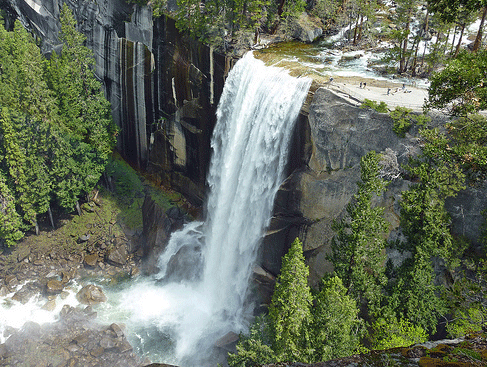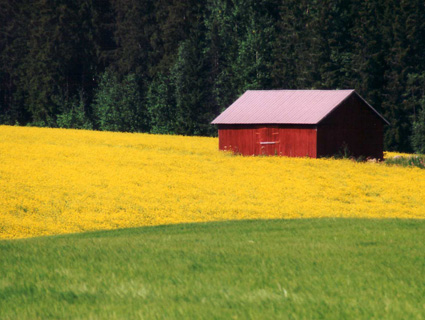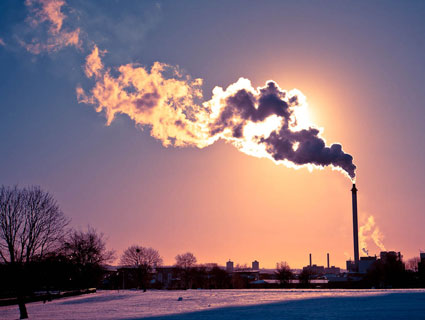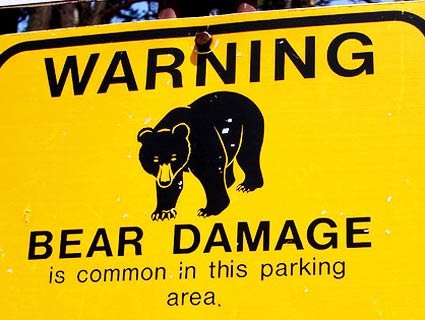
Yosemite National Park's Vernal Falls, where three hikers died in July. <a href="http://www.flickr.com/photos/72213316@N00/4690253856/sizes/m/in/photostream/" target="_blank">Alaskan Dude</a>/Flickr
Earlier this summer, a few friends and I went on a backpacking trip in Yosemite National Park. We had been told that the waterfalls were especially spectacular this year, on account of the spring melt of an unusually large snowpack. We were unprepared for just how impressive the rushing water would be. On our first day, we came to a bridge over the formidable Wapama Falls. White water poured over the railings, making the floor slick and dousing us as we scampered across. About a week after we got home, two hikers had died crossing the same bridge.
That was just the beginning of a very deadly summer in Yosemite. So far this season, 18 people have died in the park, way up from the 12 or so who die in a typical year. Thinking about the tragedies got me wondering: Could climate change be playing a role in making outdoor recreation more dangerous? And if it’s not now, then might it in the future?
The scientists I talked to agreed that there’s not enough evidence to lay the blame for this year’s high Yosemite death toll squarely on climate change. “Eighteen is an unusually high number, but things do tend to happen in waves,” says Theo Spencer, a senior advocate with the Natural Resources Defense Council’s (NRDC) Climate Center. “So it would be very hard to claim a causal relationship between climate change and this.”
But he also believes that down the line, the connection between rising temperatures and hazardous conditions will become clearer. Scientists and National Park Service officials agree that climate change has already been altering our national parks. A 2006 report by the NRDC and the Rocky Mountain Climate Organization (RMCO) found in western US wilderness areas, higher temperatures were linked to a range of potentially dangerous conditions in parks, from heat waves to insect infestations to increased storms and flooding. This year, the two organizations documented the effects of rising temperatures in parks around the Great Lakes: severe weather, decreased ice, and wildlife changes. Virginia’s Colonial National Historical Park has experienced record sea-level rise. “They’ve had to move their facilities higher and higher,” Spencer says. “They had to move their lighthouse twice.”
Climate-change-related dangers also tend to draw a certain kind of swaggering, outdoor adventurer, whose antics only create further challenges for park officials. (You know the type: carries his lunch to the office in technical gear; carabiners galore; always bragging about the first whitewater descent he bagged; etc.) “People are attracted to extreme weather events,” says RMCO president Stephen Saunders. “When there is a hurricane that makes big surf, that’s very tempting to some people.”
Bob Krumenaker is the superintendent of Wisconsin’s Apostle Islands National Lakeshore on Lake Superior. He believes that longer, milder summers could give visitors the impression that the lake, famous for its frigid waters, is safer than it actually is. “It almost creates a potential for disaster,” Krumenaker says. “People don’t typically come out to Lake Superior without proper equipment and skills, but we’re already seeing slight changes in the nature of our visitors. People are coming up with less experience.”
All of which creates a giant headache for the already cash-strapped National Park Service. “If we’re going to have more extreme weather and storms, larger snowpacks and more extreme droughts, all of that is going to take a toll on the trail, the facilities, the built environment,” says Fran Hunt, director of the Sierra Club’s Campaign for Resilient Habitats. All that work will not make things easier for the Park Service, which, according to a report that the Center for Park Research released in June, already has a maintenance backlog of $11 billion.
In addition to cleaning up the mess that extreme weather leaves behind, the Park Service will also have to ramp up communication with visitors. The agency has already launched a campaign to educate people about how the landscape might change in the coming years. Parks will also have to deploy more rangers to prevent reckless behavior, another potentially costly endeavor. “Every time we put staff out where we didn’t have staff before, that costs money,” Krumenaker says.
Frustratingly, even if parks do invest more in visitor safety education, there’s no guarantee that outdoor adventurers will heed rangers’ warnings. Krumenaker recounted to me how just this summer, park rangers at Apostle Islands warned a kayaker about big waves on the lake, but the kayaker decided to go ahead anyway. He capsized died of hypothermia just a few hours later.
In the wake of the Yosemite deaths, the park has posted a series of more drastic-sounding signs, reports the Wall Street Journal. One reads: “If you lose your footing, powerful currents will carry you over the falls. There’s no second chance.”















